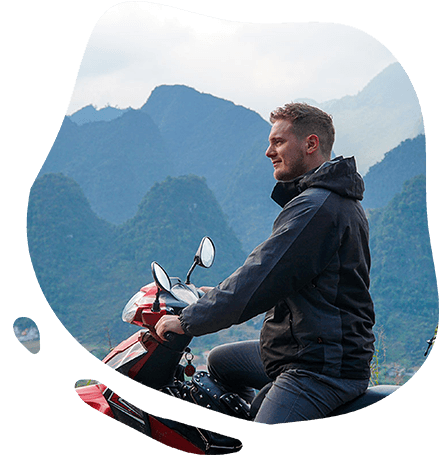Was ist das My Son Heiligtum?
Das My Son Heiligtum ist eine weitläufige archäologische Stätte mit einer Reihe beeindruckender Turmtempel, umgeben von dichtem Dschungel. 1999 wurde dieser alte hinduistische Tempelkomplex von der UNESCO zum Weltkulturerbe erklärt und repräsentiert das reiche kulturelle und religiöse Erbe des Champa-Königreichs, das einst in Zentralvietnam blühte.


Die Geschichte von My Son
Die Ursprünge von My Son reichen bis ins 4. Jahrhundert zurück und blühten zwischen dem 4. und 14. Jahrhundert als Ort religiöser Zeremonien für die Könige der herrschenden Dynastien von Champa sowie als Begräbnisstätte für Cham-Royals und nationale Helden. Im Laufe der Zeit haben aufeinanderfolgende Dynastien den ursprünglichen Komplex erweitert, was zu einer komplexen Sammlung von Tempeln und Türmen führte.
Das Champa-Imperium
Die Cham-Herrscher, die von 200 bis 1700 n. Chr. über Zentralvietnam herrschten, legten den Grundstein für zahlreiche Tempel, stark beeinflusst von hinduistischer Architektur und Ikonographie. Der Po Nagar Cham-Turm in Nha Trang ist der am besten erhaltene Tempel und dient weiterhin buddhistischen Gläubigen. My Son war in seiner Blütezeit der bedeutendste Tempelkomplex des Champa-Königreichs.
Die einzigartige Bautechnik dieser Tempel ist bemerkenswert. Aus roten Ziegeln und weichen Steinen ohne Zement gefertigt, zeigen diese Strukturen komplizierte Skulpturen von Tieren, Gottheiten und Priestern. Nach der Fertigstellung wurden die Tempel in Brand gesetzt, wodurch die Ziegel und Steine gefestigt wurden. Das Fehlen von Zement und Löchern ist ein bemerkenswertes Beispiel antiker Ingenieurskunst. My Son war nicht nur ein religiöses Zentrum, sondern spielte auch eine zentrale Rolle als politisches Zentrum und königlicher Friedhof, mit über 70 Bauwerken, die verschiedenen hinduistischen Gottheiten gewidmet sind.
Vietnamkrieg
Nach dem Niedergang des Champa-Königreichs begann die unaufhaltsame Umklammerung der Natur, My Son zu überwuchern, und der dichte Dschungel verbarg schließlich seine Existenz. Erst Ende des 19. Jahrhunderts entdeckten französische Forscher den Tempelkomplex wieder und stellten seine Bedeutung auf eine Stufe mit bekannten Stätten wie Angkor in Kambodscha und Borobudur in Indonesien.
Doch die Schatten der modernen Kriegsführung erreichten My Son in den 1960er Jahren. Obwohl es als Basis und Zuflucht für den Vietcong diente, erkannte der US-Kongress den historischen Wert an und verbot jegliche Bombardierungen hier. Tragischerweise kam es dennoch zu einigen Bombardierungen, die Schäden an den Tempelstrukturen hinterließen. Trotz dieser dunklen Phase steht der zentrale Komplex widerstandsfähig da, mit teilweise restaurierten Teilen, die still Geschichten seiner vergangenen Pracht und der turbulenten Geschichte während des Vietnamkriegs erzählen.
My Son besuchen
Abgeleitet von der Bedeutung „schöner Berg“, macht My Son seinem Namen alle Ehre, majestätisch inmitten eines lebendigen Dschungels sitzend und von hohen Gipfeln überschattet. Die anhaltende Umarmung der Natur ist offensichtlich, wenn grüne Ranken durch Risse winden und die alten Bauwerke verschlingen, was den Ruinen eine bezaubernde Aura verleiht, der kein Besucher widerstehen kann.
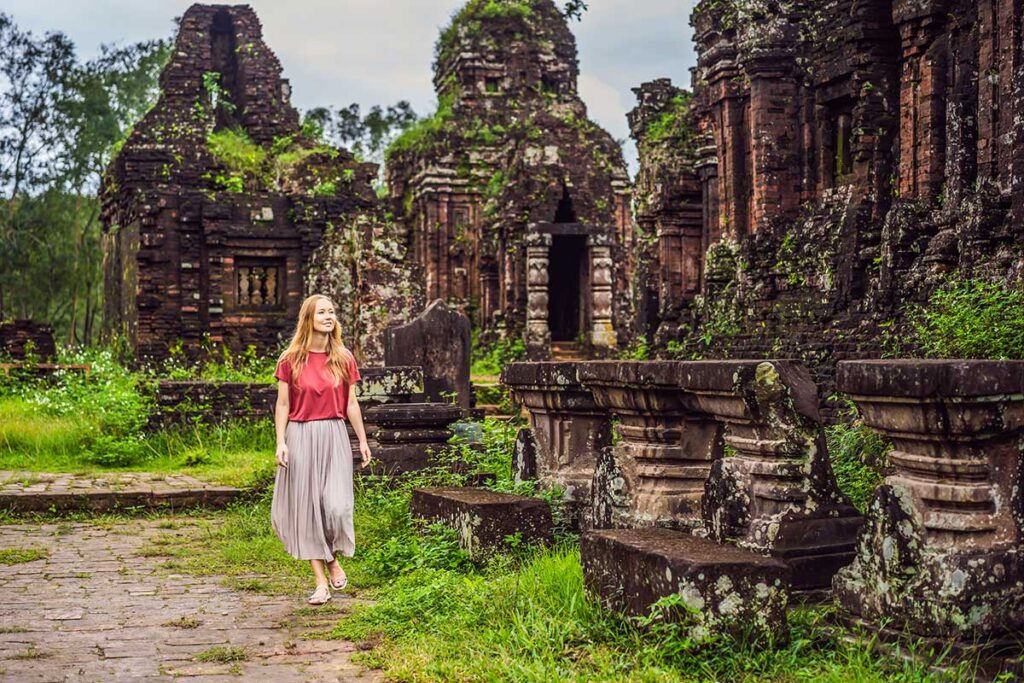
Die wichtigsten Tempel
Die Vielzahl der Tempel in My Son zeigt unterschiedliche Grade des Verfalls und der Restaurierung. Sie sind in neun verschiedene Gruppen unterteilt, die mit A bis G bezeichnet sind, wobei die Hauptgruppen A, B-C-D und E-F sind, während G, H und L isolierter und deutlich kleiner sind. Ein Netzwerk gut gepflegter Pfade erleichtert die Navigation zwischen diesen Gruppen.
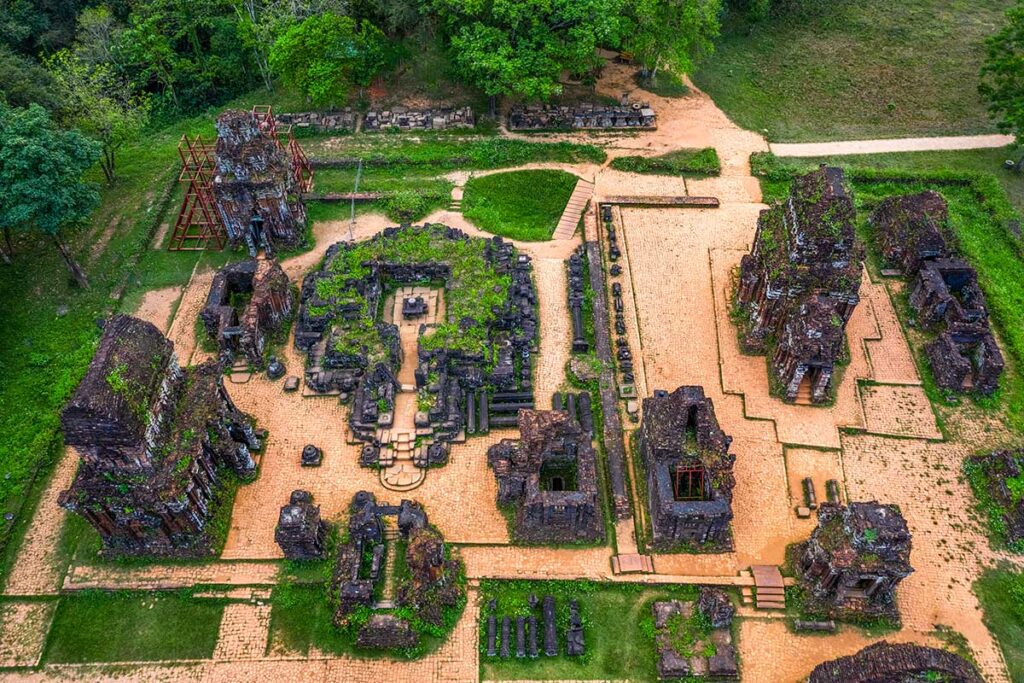
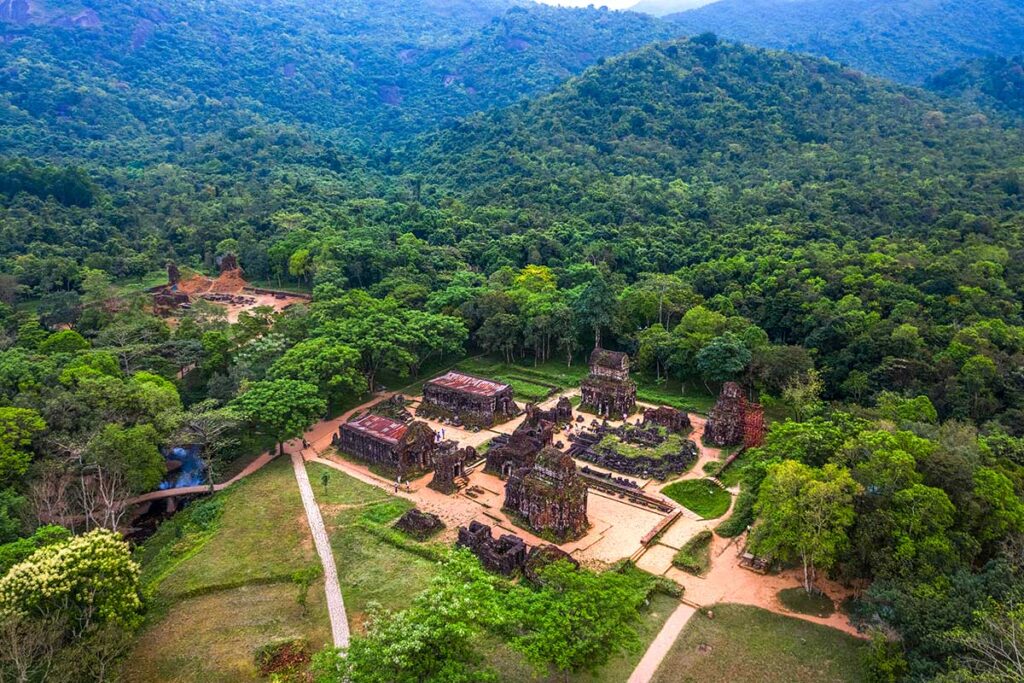
Gruppe B beherbergt das Herzstück des My Son Heiligtums. Hier findest du einen Tempel, der sowohl König Bhadravarman als auch der hinduistischen Gottheit Shiva gewidmet ist. Die lebendigen Überreste der Cham-Kunst sind hier besonders gut erkennbar. Zudem bekräftigt ein ausgegrabener Linga, das Symbol für Shiva im Hinduismus, die spirituelle Bedeutung des Ortes.
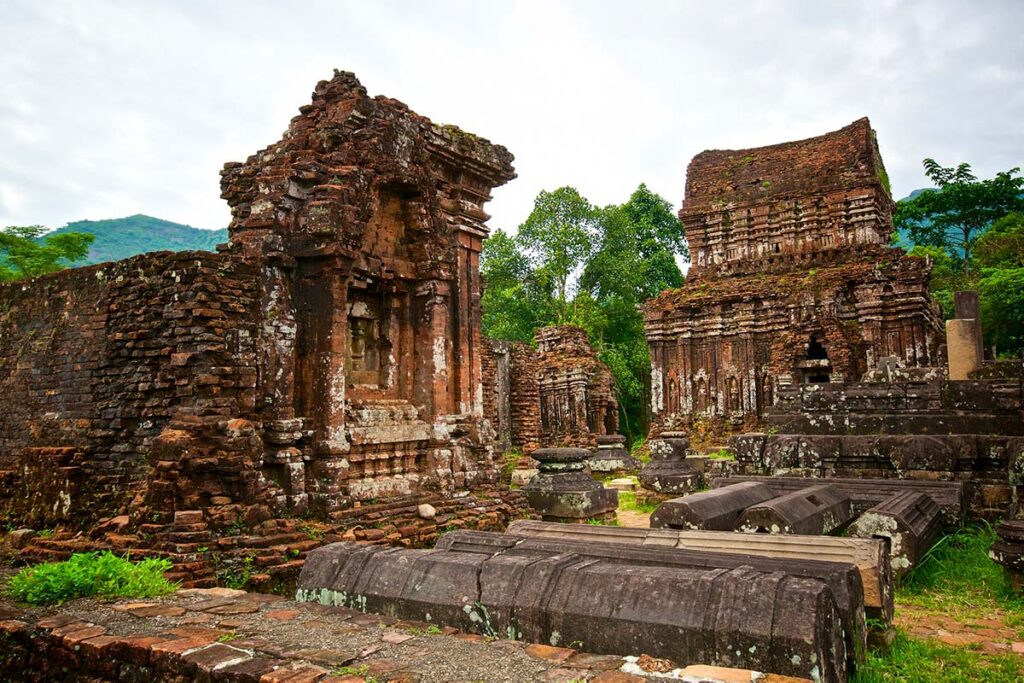
Teile des Komplexes zeigen die Narben der Bombardierungen, die jetzt von Gras überwuchert sind und die einstige Pracht der Jahrhunderte alten Strukturen verbergen. Zwischen diesen Relikten des Krieges sind Zeichen der Restaurierung sichtbar, neben verbliebenen Kugelspuren und verwandelten Bombenkratern, die jetzt als ruhige Teiche dienen.

Museen
Nahe dem Eingang steht ein Museum, das der Champa-Kultur gewidmet ist. Reich an Artefakten und Statuen, bietet es dir einen Einblick in die vergangene Pracht des Heiligtums.
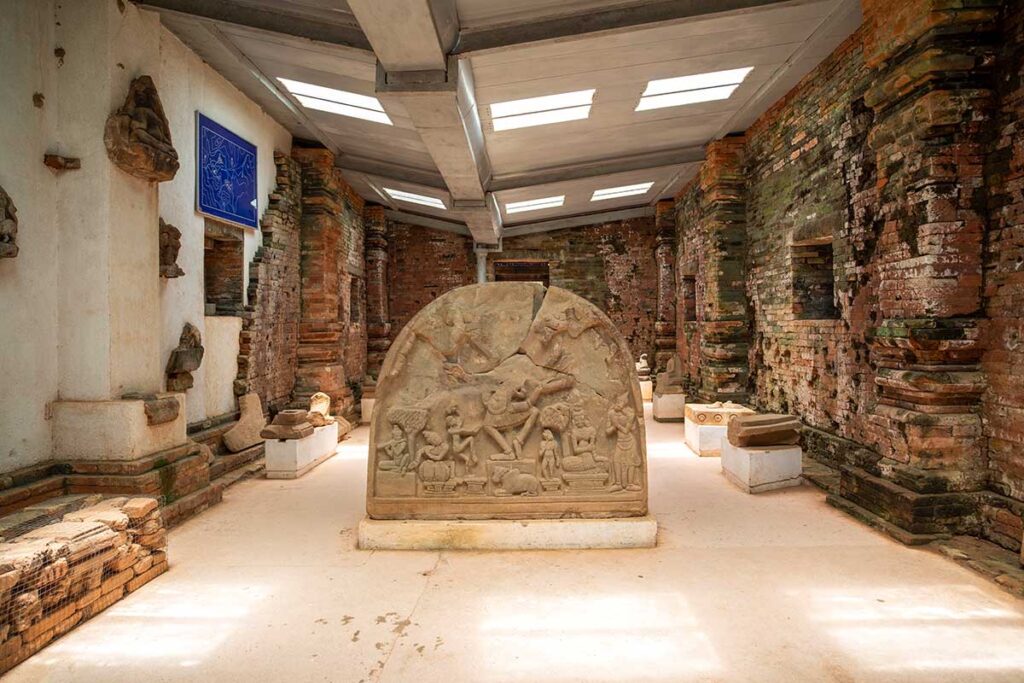
Während viele der gut erhaltenen Skulpturen in diesen Museumsräumen ihren Platz gefunden haben, wurden andere in eine zweite Ausstellung innerhalb der Gruppe A verlegt. Um die Geschichte und Bedeutung der Stätte vollständig zu verstehen, empfiehlt es sich, diese Museen zu besuchen, bevor du die Ruinen erkundest.
Kulturelle Tanzaufführung
Wenn du nach einer Dosis lokaler Kultur suchst, werden täglich um 9:30 Uhr und 10:30 Uhr traditionelle Tanzaufführungen veranstaltet. Diese richten sich hauptsächlich an morgendliche Reisegruppen. Die Bühne befindet sich praktischerweise auf dem Weg zu den ersten Ruinen, in direkter Nähe zu einem Souvenirladen.
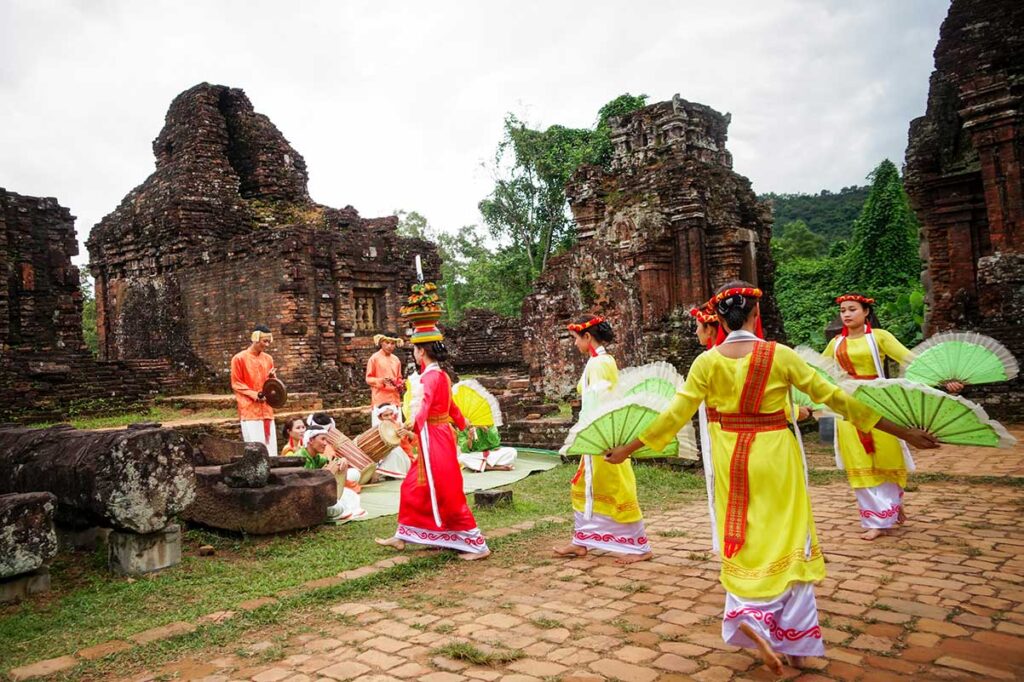
My Son See
Ein oft übersehenes Juwel sind die Bäche innerhalb des My Son-Komplexes, die schließlich in einen ruhigen, abgelegenen See münden. Dieses unberührte Paradies bleibt oft abseits der typischen Touristenpfade und bietet ein friedliches Erlebnis beim Kajakfahren. Der drei Kilometer lange See lädt dich ein, gemütlich durch die Natur zu paddeln. Zahlreiche Mietmöglichkeiten für Kanus und Kajaks findest du während der Fahrt zu My Son und nahe des Eingangs, was es zu einer reizvollen Ergänzung der Tempelerkundung macht.
Eintrittspreis und Öffnungszeiten
- Eintrittsgebühr: 150.000 VND (einschließlich My Son Heiligtum und Champa Museum)
- Parkgebühr für Roller: 5.000 VND
- Öffnungszeiten:
- Täglich von 6:30 Uhr bis 17:30 Uhr
Hinweis: Die oben genannten Gebühren gelten für einen unabhängigen Besuch von My Son. Diese Kosten sind normalerweise in den meisten Tourpaketen enthalten.
Tipps:
- Kleide dich respektvoll: Aufgrund der spirituellen Bedeutung von My Son solltest du darauf achten, dass deine Kleidung die Schultern, den Bauch und die Knie bedeckt.
- Plane deinen Besuch: Morgens gibt es oft viele Gruppenreisen, während es nachmittags sehr heiß sein kann. Wähle deine Besuchszeit basierend auf deinen Vorlieben und deiner Vorbereitung auf das Wetter.
Wie du My Son unabhängig erreichst
Taxi oder privates Auto
- Kosten: Rechne mit 30 bis 50 Euro, wenn du ein Taxi nimmst.
- Bessere Alternative: Überlege, ein Auto mit Fahrer zu mieten und einen Festpreis im Voraus zu verhandeln. Das bietet dir Flexibilität im Zeitplan, sodass du früh ankommen kannst, bevor die Menschenmassen eintreffen.
- Vergleich mit Touren: Obwohl du mit einem privaten Auto mehr Freiheit hast, ist der Preis möglicherweise nicht kostengünstiger als bei Touren, besonders wenn du nur zu zweit unterwegs bist. Touren bieten häufig zusätzliche Aktivitäten und Stopps, die sie wertvoll machen.
Mit dem Motorrad
- Miete: Roller können in Da Nang oder Hoi An für etwa 5 Dollar (100.000 VND) gemietet werden.
- Benzin: Die Treibstoffkosten für die Hin- und Rückfahrt von Hoi An betragen etwa 3-4 Dollar.
- Sicherheitsbedenken: Das Fahren in Vietnam birgt Risiken. Wenn du keine Erfahrung hast oder keinen gültigen Motorradführerschein besitzt, ziehe andere Reisemöglichkeiten in Betracht.
- Routenempfehlungen: Obwohl die Hauptstraße der schnellste Weg nach My Son ist, bieten die Landstraßen oder Strandstraßen eine sicherere und malerischere Fahrt, bei der du größere Fahrzeuge vermeiden kannst.
My Son Touren von Hoi An
Es werden zahlreiche Touren nach Hoi An angeboten. Es ist wichtig, dass du im Voraus sorgfältig prüfst, welche Art von Tour es ist. Es gibt schon sehr günstige Touren ab 5 Dollar, aber das bedeutet oft, dass du in einer großen Gruppe unterwegs bist, die Eintrittsgebühren nicht inbegriffen sind und du nicht viel Zeit hast, um alle Tempel zu sehen.
Lokale Vietnam My Son Tour in kleiner Gruppe von Hoi An
- Abholung und Rückfahrt zum Hotel.
- Reisen in einer kleinen Gruppe in einem komfortablen Van.
- Ausreichend Zeit, um My Son zu erkunden.
- Zusätzliche Attraktionen wie ein traditioneller Reispapier-Workshop.
- Mittagessen bei einer einheimischen Familie.
- Eine malerische Bootsfahrt auf dem Thu Bon Fluss, die dir einen Einblick in die idyllische Landschaft und das Flussleben bietet, bevor es zurück nach Hoi An geht.
